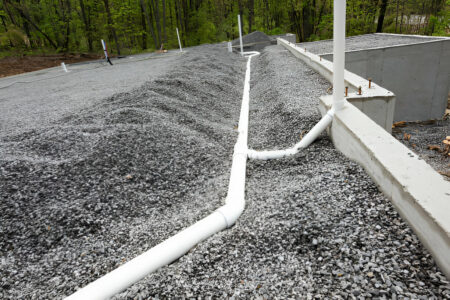Proper drainage is essential for maintaining the integrity of any property, preventing water damage, and ensuring safety. One effective solution for managing surface water is the installation of channel drains. This article will guide you through everything you need to know about channel drain installation, from understanding what they are to the step-by-step process of installing one.
What is a Channel Drain?
A channel drain, also known as a trench drain, is a linear drainage system designed to collect and transport surface water efficiently. These drains are commonly used in areas prone to water accumulation, such as driveways, patios, pool decks, and industrial sites. The benefits of channel drains include preventing flooding, reducing soil erosion, and protecting structures from water damage.
Types of Channel Drains
Channel drains come in various materials, each suited to different environments and applications:
- Plastic Channel Drains: Lightweight and easy to install, ideal for residential use.
- Metal Channel Drains: Durable and suitable for areas with heavy traffic.
- Concrete Channel Drains: Extremely robust, perfect for industrial and commercial sites.
Materials Needed for Installation
Before starting your installation, gather the necessary materials:
- Channel drain kits
- Gravel and sand
- PVC pipes
- Concrete mix
Planning the Installation
Proper planning is crucial for a successful installation:
- Assessing the Area: Identify areas where water tends to accumulate.
- Determining the Slope: Ensure a proper slope for effective drainage.
- Drawing a Layout Plan: Plan the layout to determine the length and direction of the trench.
Excavation and Preparation
Follow these steps to prepare the site:
- Marking the Trench: Use stakes and string to mark the path of the trench.
- Digging the Trench: Excavate the trench to the required depth and width.
- Adding a Gravel Base: Lay a base of gravel for stability and drainage.
Assembling the Channel Drain
Once the site is prepared, assemble the drain:
- Cutting the Channel Drain to Fit: Measure and cut the drain sections to fit the trench.
- Connecting Sections: Use connectors to join multiple sections.
- Sealing Joints: Apply sealant to ensure watertight joints.
Installing the Channel Drain
Place the assembled drain into the trench:
- Placing the Channel Drain in the Trench: Ensure the drain is correctly positioned.
- Adjusting for Level and Slope: Make sure the drain follows the desired slope.
- Backfilling Around the Drain: Fill the sides of the trench with gravel and soil for stability.
Connecting to the Drainage System
Ensure proper water flow by connecting the drain to the drainage system:
- Attaching PVC Pipes: Connect the outlet of the channel drain to PVC pipes.
- Ensuring Proper Water Flow: Check for unobstructed flow to the main drainage system.
- Securing Connections: Use clamps or adhesive to secure pipe connections.
Pouring Concrete Around the Drain
Stabilize the drain by pouring concrete:
- Mixing Concrete: Prepare the concrete mix according to the manufacturer’s instructions.
- Pouring and Spreading Concrete: Pour the concrete around the drain, spreading it evenly.
- Smoothing the Surface: Use a trowel to smooth the concrete surface for a clean finish.
Finishing Touches
Complete the installation with these final steps:
- Installing Grates: Place grates over the channel drain to keep debris out.
- Checking for Obstructions: Ensure there are no blockages in the drain.
- Final Inspections: Inspect the entire installation for any issues.
Maintenance Tips for Channel Drains
To keep your channel drain functioning effectively, follow these maintenance tips:
- Regular Cleaning: Remove debris and leaves regularly.
- Inspecting for Damage: Check for cracks or damage periodically.
- Seasonal Maintenance: Perform thorough maintenance at the start and end of each season.
Common Mistakes to Avoid
Avoid these common mistakes during installation:
- Incorrect Slope: Ensure the trench has the correct slope for drainage.
- Poor Sealing: Seal joints properly to prevent leaks.
- Inadequate Maintenance: Regularly maintain the drain to prevent blockages.
Benefits of Professional Installation
Consider hiring professionals for the best results:
- Expertise and Experience: Professionals have the knowledge and skills for a flawless installation.
- Proper Equipment: They use specialized tools for efficiency and precision.
- Time and Effort Saved: Hiring professionals saves you time and effort.
FAQs
How long does a channel drain installation take?
The installation process can take anywhere from a few hours to a couple of days, depending on the size of the project and site conditions.
Can I install a channel drain myself?
Yes, with the right tools and instructions, DIY installation is possible, but professional installation is recommended for larger or more complex projects.
How often should I clean my channel drain?
It’s best to clean your channel drain at least twice a year, or more frequently if you notice debris buildup.
What are the signs of a blocked channel drain?
Signs include slow drainage, water pooling around the drain, and unusual odors.
Are there eco-friendly options for channel drains?
Yes, some channel drains are made from recycled materials, and there are designs that promote natural filtration and groundwater recharge.
How Deep Should a Channel Drain Be?
The depth of a channel drain can vary based on the specific product and the amount of water it needs to handle. However, a general guideline is to dig the trench to a depth that accommodates the drain itself plus an additional few inches for a base layer (such as gravel) and the concrete surround. Here’s a step-by-step outline for determining the proper depth:
- Check the Drain Dimensions: Measure the height of your channel drain. Most residential channel drains are about 4 to 6 inches tall.
- Base Layer: Add a base layer of gravel, typically 2 to 4 inches, to provide stability and facilitate drainage.
- Concrete Surround: Plan for at least 2 inches of concrete beneath and around the sides of the drain for added stability.
Conclusion!!
Proper channel drain installation is vital for effective drainage and protection of your property. By following this comprehensive guide, you can ensure a successful installation that will serve you well for years. Don’t hesitate to seek professional help if needed, and remember to maintain your channel drain regularly to keep it in optimal condition.







